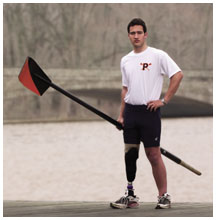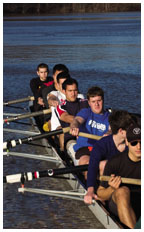Have an opinion about this issue of PAW? Please take a minute to click here and fill out our online questionnaire. It’s an easy way to let the editors know what you like and dislike, and how you think PAW might do better. (All responses will be kept anonymous.) |
April 20, 2005: Features
Photographs by Ricardo Barros |
One
of the crew
An athlete’s disability is no match for
love of his sport
By Brett Tomlinson
For most collegiate rowers, mornings on the water are a matter of routine. But at Princeton, where crew practice normally occupies the late afternoon, sunrise sessions are special, reserved for spring break, when the team practices twice a day. “You push out in the morning, and there’s still mist on the water,” says Jesse Karmazin, a sophomore on the men’s heavyweight team. “It’s a beautiful sight.”
The surroundings may be placid, but inside the boat it’s a different story, especially in mid-March in the days after Lake Carnegie has thawed. As the eight-man shells cut through the cold breeze and flat water with powerful surges, Karmazin and his teammates exert every available muscle while straining to maintain efficient technique. Clad in ski caps and windbreakers, they alternate between sweating and freezing. After a hot shower, a warm meal, and a few hours of rest, the rowers return to the water for an afternoon session. By the end of the week, Karmazin says, the sport is so ingrained that it enters your dreams.
Competitive rowing requires a certain kind of athlete — one who is tough, self-motivated, and indefatigable. According to the Princeton coaches, Karmazin fits the description. Like many rowers, he walked onto the team as a freshman, knowing little about the sport. But unlike his peers, he had to overcome physical challenges beyond strength and endurance training. Karmazin was born without a right foot and ankle, and for as long as he can remember, he has been walking with help from a prosthesis that connects just below his right knee. The disability hampered his progress in the first of his two years on the water, but it hasn’t tempered his passion for rowing.
From top of photo, Tom Tullius ’07, Scott Debenedett ’08 (obscured), Zhen Xia ’08, Geoff Nelson ’08, Karmazin, Paul Kelly ’05, Tom Zingale ’08, and Joe Vogel ’08 during a practice session in March. |
Karmazin, the first athlete with a disability to row for Princeton, was introduced to crew when one of the team’s upperclassmen walked through the dorms looking for freshmen big and strong enough to pull an oar. It sounded interesting, so he decided to go to tryouts. He had played soccer and baseball as a kid, and his leg had never been a problem. “It really never occurred to me that I might not be able to do something,” Karmazin says. With rowing, though, he wasn’t so sure. He told the coaches he would like to try, and they taught him the basics of the stroke on the ergometer, the rowing machine used in training.
The motion was awkward at first. The leg muscles are the most important muscle group that rowers use, and Karmazin’s prosthesis, built for stability while walking, made it difficult to maximize the strength of his lower body. Other rowers could reach a seated position in which their heels and backsides were almost touching, allowing them to accompany each pull of the oar with a powerful leg push. Karmazin’s range was limited and less forceful, however, because the ankle joint did not allow his foot to bend backward. Still, he kept working, and kept improving, using as much flexibility as he could. Assistant coach Greg Hughes ’96 says that about half of the team’s prospective walk-ons don’t return for the second day of practice. Karmazin did more than just come back to the boathouse. He kept training for an hour and a half each day throughout the fall and winter, even after failing to earn a seat on one of the freshman boats in the fall. “Jesse has proven himself to be a pretty remarkable athlete, in terms of his approach to how he trains and his attitude toward the sport,” says Hughes, a rower on two lightweight national championship boats at Princeton. “I have kids who don’t have that approach, and you have to teach it.”
When Karmazin returned home to Palm Beach Gardens, Fla., for winter recess during his freshman year, he was visibly transformed, according to his father, Brian. His waist had tapered, and his shoulders had broadened. He kept up with his training over the break, making trips to West Palm Beach to row at a local club. The work ethic that the sport demands seems perfectly matched for Jesse’s personality, his father says. “It’s that drive,” he says. “He’s always been very competitive, with everything he’s done in life.”
The drive paid off last spring, when Karmazin made a breakthrough in his rowing, with some help from his coach and the University. Hughes had been talking with Tom Hewitt, an assistant coach at Rutgers who had worked with athletes with physical limitations or disabilities, who are known as adaptive athletes. Hewitt told Hughes about a doctor in New York who might be able to make Karmazin a prosthetic leg more suited for rowing.
Karmazin went to get fitted for a new leg from A Step Ahead, a Long Island, N.Y.-based company that designs custom prosthetic limbs for athletes, but he soon realized that such high-performance prosthetics can cost upwards of $20,000, a significant investment for an undergraduate. Hughes and Karmazin began searching around the University for someone who could help and eventually found financial assistance from the dean of undergraduate students. Karmazin got his new prosthesis, which included a hinging ankle joint for more flexibility and a rigid shin to allow him to push off with his right leg.
After a few sessions on the rowing machine with the new leg, Karmazin took a single-scull boat (one rower, two oars) out on Lake Carnegie, and the change in his form was almost immediate. Whatever awkwardness his walking leg had caused quickly dissipated, and his strokes became stronger and more technically sound. Says Hughes, “He looked like a rower.” Karmazin soon noticed a difference in his conditioning. As he learned to use his right leg more effectively, he could row longer stretches without tiring.
With improved training times and a surge of confidence, Karmazin went to Philadelphia for the selection of the U.S. adaptive rowing team. He qualified for the U.S. four-person boat with coxswain, which included two men and two women. He traveled with the team to Banyoles, Spain, for the adaptive world championships, held in conjunction with the International Federation of Rowing Associations World Championships in July 2004. Though his boat failed to medal, Karmazin valued the experience nonetheless — particularly the chance to meet competitors from the world’s top crews. Isabel Bohn, chairwoman of U.S. Rowing’s Adaptive Committee, says that adaptive rowing needs more athletes like Karmazin, and more coaches like those on the Princeton staff, to help it grow as a competitive sport. “Most rowing coaches would never think to have someone with a disability on their crew,” she says. “They just have no experience with it.”
On the water, it’s easy to forget about Karmazin’s prosthesis. From the bow side of the boat, his left leg blocks the white casing that begins below his right knee. He rows with his chin up, in keeping with good form, and an unwavering forward stare that befits the “Zen-like” characteristic that he says got him hooked on the sport. On the shore, Karmazin swaps out the ankle-hinging rowing leg for his walking leg so he can wash down the boat with his teammates and carry it back into the boathouse. He is, in every way, a part of the Princeton team. Last year, he says, he was probably the program’s worst rower. This year, he’s keeping pace with the freshman walk-ons, and since he did not row for the freshman eights last season, he is still eligible to compete in freshman races. Hughes expects to have Karmazin rowing in the second freshman boat this spring, with a chance of being bumped up to the varsity. “I guess it took me an extra year,” Karmazin says, “but that’s not too much of a sacrifice.”
Away from the water, Karmazin balances a course load that includes several classes in the sciences. He is still trying to decide between majoring in molecular biology or chemistry, and he hopes to attend medical school, inspired in part by his own experiences in hospitals as a child, when he had to return periodically to have the bone in his leg reshaped. “Looking back,” he says, “I see how much doctors helped me — how they’re there when you’re at your weakest, when you’re in pain, when you need someone’s help.”
In the near future, Karmazin wants to continue improving his fitness and find a seat on one of the Princeton varsity boats. With his new prosthesis, he says, conditioning is the only limiting factor. There is an international movement to get rowing added to the Paralympics, the world’s premier competition for disabled athletes, and if the sport is contested at the 2008 Paralympics in Beijing, Karmazin hopes to be there. He also plans to keep rowing, at least recreationally, well beyond 2008, following the example set by the octogenarians from Princeton’s community rowing program whom he sees on Lake Carnegie.
The attraction to rowing is simple, Karmazin says: “You can learn
the basics pretty easily, but it takes forever to master. And your success
is a function of how much work you put in.” ![]()
Brett Tomlinson is an associate editor at PAW, in charge of sports coverage.



